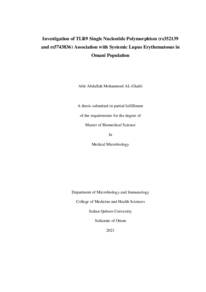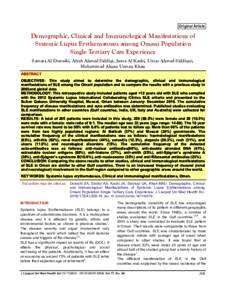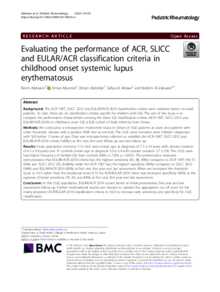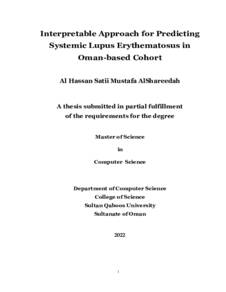Document
Investigation of TLR9 single nucleotide polymorphism (rs352139 and rs5743836) association with systemic lupus erythematosus in Omani population.
Other titles
استقصاء تعدد أشكال النوكليوتيدات المفردة 9TLR وعلاقتها بمرض الذئبة الحمراء (SLE) لدى العمانيين
Publisher
Sultan Qaboos University.
Gregorian
2021
Language
English
English abstract
Introduction: Systemic lupus erythematosus (SLE) is a complex chronic autoimmune
disease with heterogeneous features and multi-organ involvement such as skin, kidney,
joints and heart causing a broad range of clinical manifestations. It is characterized by
production of autoantibodies directed to diverse nuclear antigens, including double stranded DNA (dsDNA), ribonucleoproteins (RNP) and smith protein (Sm). Breakdown
of immunological tolerance and environmental, genetic and hormonal factors contribute
to the onset and severity of SLE. Toll-like receptor 9 (TLR9) is a member of TLRs,
which belong a family of pattern recognition receptors, and it plays an important role in
innate immunity. Several studies have found that polymorphisms in TLR9 gene are
associated with SLE in different ethnic populations. Therefore, this study aimed to
assess the relationship between TLR9 SNPs, rs352139 (+1174G/A) and rs5743836 (-
1237C/T), and SLE among Omani population. The specific aims of this study were to
determine (1) the genotype and allelic frequency of TLR9 SNPs rs352139 and
rs5743836 in Omani SLE patients and healthy control; (2) the association of TLR9 SNP
genotypes with the risk of SLE; (3) the association of TLR9 SNP genotypes with APL
antibodies; and (4) the association of TLR9 SNP genotypes with thrombocytopenia.
Methods: The study population included two groups: 99 adult Omani patients who have
been diagnosed with SLE and attending the Rheumatology Clinic at Sultan Qaboos
University Hospital (SQUH) for follow-up and 96 apparently healthy volunteers. The
whole blood was collected from each study participant, and genomic DNA was isolated.
The gene segments containing TLR9 SNPs rs352139 and rs5743836 were amplified by
polymerase chain reaction (PCR) using specific forward and reverse primers. The
amplified DNA samples were sequenced using Sanger sequencing and their sequences
were analyzed to identify TLR9 SNP genotypes.
Results: There was no significant association between the TLR9 SNP rs352139 and
rs5743836 genotypes and susceptibility to SLE in this study population. However, we
found that rs352139 GG and rs5743836 CC genotypes were significantly associated
with the occurrence of anti-cardiolipin (aCL) IgM (p=0.034 and p=0.028, respectively).
In addition, rs352139 GG genotype was significantly associated with the
thrombocytopenia (p=0.0078). In contrast, rs352139 AG genotype was significantly
associated with protection from developing thrombocytopenia in SLE patients
(p=0.0109). Furthermore, the study revealed that the presence of aCL antibodies was
significantly associated with an increased risk of thrombocytopenia in SLE patients
(p=0.036). Likewise, we found a significant association between the presence of anti dsDNA antibody and renal disorder among the SLE patients (p=0.013).
Conclusion: TLR9 SNPs rs352139 and rs5743836 are not associated with the risk SLE
among Omani population. However, the results suggest that both TLR9 SNPs may have
an influence on aCL antibody production and rs352139 may affect the development of
thrombocytopenia in Omani SLE patients.
Member of
Resource URL
Arabic abstract
المقدمة: يعتبر مرض الذئبة الحمراء من أمراض المناعة الذاتية المزمنه ذات الطبيعة المعقدة. يتميز هذا المرض بأعراض مختلفة وإصابة أعضاء عديده مثل الجلد والكلى والمفاصل والقلب مما يسبب مجموعة واسعة من الأعراض السريرية. يتميز بإنتاج الأجسام المضادة الذاتية الموجهة إلى أحماض نووية متنوعة ، بما في ذلك الحمض النووي الريبي منقوص الأوكسجين ذو السلسلة المزدوجة (dsDNA (والبروتينات الريبية (RNP )وبروتين سميث (Sm(. يساهم فقدان الجهاز المناعي قدرته على تجاهل جزئيات الذات و كذلك العوامل البيئية والجينية والهرمونية في ظهور وشدة مرض الذئبة الحمراء. يعتبر المستقبل التاسع الشبيه التول (9TLR (أحد عناصرعائلة المستقبالت شبيهات التول )TLRs (، وهي عائلة من مستقبلات التعرف على الأنماط. يلعب 9TLR دو ًرا مهًما في المناعة الغير مكتسبة. وجدت العديد من الدراسات أن تعدد الأشكال في جين 9TLR يرتبط بخطر الأصابة بمرض الذئبة الحمراء في مجموعات عرقية مختلفة. هدفت هذه الدراسة إلى تقييم العالقة بين 352139rs) A/G+1174( ,(T/C-1237 (5743836rs و مرض الذئبة الحمراء بين السكان العمانيين. كانت الأهداف المحددة لهذه الدراسة هي تحديد )1( التركيب الجيني والتردد الأليلي لـ SNPs 9TLR 352139rs و 5743836rs في مرضى SLE العمانيين والتحكم الصحي. )2( ارتباط الأنماط الجينية SNPs 9TLR بخطر الأصابة بمرض الذئبة الحمراء ؛ )3( ارتباط الأنماط الجينية SNP 9TLR بالأجسام المضادة لـ APL ؛ و )4( ارتباط الأنماط الجينية 9TLR SNPs بنقص الصفيحات. مري ًضا عمانيًا بالغا ض الذئبة ً الخطوات: اشتملت عينات الدراسة على مجموعتين: 99 تم تشخيص إصابتهم بمر الحمراء يتعالجون في عيادة أمراض الروماتيزم في مستشفى جامعة السلطان قابوس و 96 متطو ًعا يتمتعون بصحة جيدة. بعد ذلك تم جمع عينات الدم من كل مشارك في الدراسة ، وعزل الحمض النووي الجيني. تم مضاعفة النسخ الجينية التي تحتوي على الأشكال النكليوتيديه المنفرد )SNP )لكل من 352139rs و 5743836rs عن طريق التفاعل التسلسي بأنزايم البوليماريز (PCR (باستخدام بادئات أمامية وعكسية محددة. تم تسلسل عينات الحمض النووي المضاعفة باستخدام طريقة سانجر لتحديد الأنماط الجينية لألشكال النكليوتيديه المنفرده الخاصة بالمستقبل التاسع الشبيه البتول. النتائج: وجدنا عدم ارتباط كبير بين الأنماط الجينية لألشكال النكليوتيديه المنفرده الخاصة بالمستقبل التاسع الشبيه البتول 352139rs و 5743836rs و قابلية الأصابة بمرض الذئبة الحمراء في عينات الدراسة هذه. ومع ذلك ، وجدنا أن الأنماط الجينية GG 352139rs و CC 5743836rs كانت مرتبطة بشكل كبير بوجود مضادات الكارديوليبين (aCL (من نوع IgM) 0.034=p و 0.028=p على التوالي(. بالأضافة إلى ذلك ، ارتبط النمط الجيني GG 352139rs بشكل كبير بنقص الصفيحات الدموية (0.0078=p (. علاوة على ذلك ، كشفت الدراسة ا بشكل كبير بزيادة خطر الأصابة بنقص الصفيحات الدموية أن وجود الأجسام المضادة لكارديوليبين كان مرتبطً XI كذلك ، وجدنا ارتباطً dsDNA في مرضى الذئبة الحمراء (0.0368=p(. ا مهًما بين وجود الأجسام المضادة لـ والأضطراب الكلوي بين مرضى الذئبة الحمراء (0.013=p (. الخاتمة: في الختام ، ال ترتبط SNPs 9TLR 352139rs و 5743836rs بتطور مرض الذئبة الحمراء بين ن كالً 9TLR قد يكون لهما تأثير على السكان العمانيين. ومع ذلك ، تشير النتائج إلى أ من تعدد الأشكال في جين إنتاج الأجسام المضادة لـ aCL وقد يؤثر 352139rs على تطور نقص الصفيحات الدموية في مرضى الذئبة الحمراء.
Category
Theses and Dissertations






